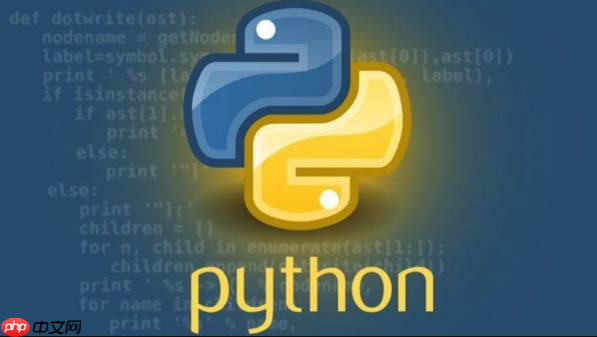python操作配置文件并實現熱更新的方法有:1.使用configparser模塊處理.ini格式文件,json和yaml處理復雜數據結構;2.通過watchdog庫監控文件變化或定時檢查實現熱更新;3.用try-except捕獲異常來處理加載失敗;4.采用面向對象設計可擴展的配置系統。具體步驟包括讀取、修改、寫入配置文件,監聽文件變動觸發重新加載,以及結合多配置源提升靈活性。

python中操作配置文件,核心在于解析和修改,而熱更新則需要在文件變動時自動重新加載配置。簡單來說,就是讀取、修改、再讀取。

解決方案
Python處理配置文件的常用方式包括使用configparser模塊、json、yaml等。configparser適合.ini格式,json和yaml則更靈活,可以應對更復雜的數據結構。熱更新的實現,通常依賴文件監控或者定時檢查。

- configparser 示例:
import configparser config = configparser.ConfigParser() config.read('config.ini') # 讀取配置 value = config['Section1']['key'] # 修改配置 config['Section1']['key'] = 'new_value' # 寫入配置 with open('config.ini', 'w') as configfile: config.write(configfile)
- json 示例:
import json with open('config.json', 'r') as f: config = json.load(f) # 讀取配置 value = config['key'] # 修改配置 config['key'] = 'new_value' # 寫入配置 with open('config.json', 'w') as f: json.dump(config, f, indent=4) # indent參數用于美化json格式
- yaml 示例:
import yaml with open('config.yaml', 'r') as f: config = yaml.safe_load(f) # 讀取配置 value = config['key'] # 修改配置 config['key'] = 'new_value' # 寫入配置 with open('config.yaml', 'w') as f: yaml.dump(config, f, indent=4)
如何監控配置文件變化實現熱更新?
可以使用watchdog庫來監控文件變化。watchdog可以監聽文件系統的事件,例如文件的創建、修改、刪除等。當配置文件發生變化時,重新加載配置。
立即學習“Python免費學習筆記(深入)”;
import time import configparser from watchdog.observers import Observer from watchdog.events import FileSystemEventHandler class ConfigChangeHandler(FileSystemEventHandler): def __init__(self, config_parser, config_file): self.config_parser = config_parser self.config_file = config_file def on_modified(self, event): if event.src_path == self.config_file: print(f'Configuration file {self.config_file} changed, reloading...') self.config_parser.read(self.config_file) # 在這里執行重新加載配置后的操作,例如更新全局變量等 config = configparser.ConfigParser() config.read('config.ini') event_handler = ConfigChangeHandler(config, 'config.ini') observer = Observer() observer.schedule(event_handler, path='.', recursive=False) # 監聽當前目錄下的config.ini文件 observer.start() try: while True: # 主程序邏輯 print(f"Current value: {config['Section1']['key']}") time.sleep(5) except KeyboardInterrupt: observer.stop() observer.join()
這段代碼創建了一個監聽器,當config.ini文件被修改時,on_modified方法會被調用,重新加載配置文件。 記得安裝watchdog: pip install watchdog。

除了watchdog,還有其他熱更新的方案嗎?
除了watchdog,還可以使用inotify(linux系統)或者簡單的定時輪詢。 inotify是Linux內核提供的一種文件系統事件通知機制,比watchdog更底層,性能更高,但使用起來稍微復雜一些。
定時輪詢則是定期檢查文件的修改時間,如果修改時間發生了變化,就重新加載配置文件。 這種方法簡單粗暴,但會消耗一定的系統資源。
import time import os import configparser config = configparser.ConfigParser() config.read('config.ini') last_modified = os.path.getmtime('config.ini') while True: time.sleep(5) current_modified = os.path.getmtime('config.ini') if current_modified != last_modified: print('Configuration file changed, reloading...') config.read('config.ini') last_modified = current_modified # 在這里執行重新加載配置后的操作,例如更新全局變量等 print(f"Current value: {config['Section1']['key']}")
如何處理配置文件加載失敗的情況?
配置文件加載失敗可能是文件不存在、格式錯誤、權限問題等引起的。 需要加入異常處理機制,保證程序的健壯性。
import configparser config = configparser.ConfigParser() try: config.read('config.ini') except configparser.Error as e: print(f"Error reading config file: {e}") # 可以選擇使用默認配置,或者退出程序 config['DEFAULT'] = {'key': 'default_value'} # 使用默認配置 except FileNotFoundError: print("Config file not found.") config['DEFAULT'] = {'key': 'default_value'} except Exception as e: print(f"An unexpected error occurred: {e}") # 記錄日志,方便排查問題 config['DEFAULT'] = {'key': 'default_value'} # 使用配置 value = config['Section1'].get('key', config['DEFAULT']['key']) # 如果Section1或key不存在,使用默認值 print(value)
使用try…except塊捕獲可能發生的異常,并進行處理。 可以選擇使用默認配置,或者記錄日志并退出程序。get方法可以指定默認值,避免因為配置項不存在而導致程序崩潰。
如何設計一個可擴展的配置系統?
可擴展的配置系統需要考慮配置的層次結構、配置的覆蓋規則、配置的驗證機制等。 可以使用面向對象的設計思想,將配置抽象成類,不同的配置源(例如文件、環境變量、命令行參數)抽象成不同的類,通過組合和繼承來實現靈活的配置管理。
import configparser import os class Configsource: def get(self, key, default=None): raise NotImplementedError class FileConfigSource(ConfigSource): def __init__(self, filename): self.filename = filename self.config = configparser.ConfigParser() try: self.config.read(self.filename) except Exception as e: print(f"Error reading config file: {e}") self.config['DEFAULT'] = {} def get(self, key, default=None): try: return self.config['DEFAULT'].get(key, default) except KeyError: return default class EnvironmentConfigSource(ConfigSource): def get(self, key, default=None): return os.environ.get(key, default) class Config: def __init__(self, sources): self.sources = sources def get(self, key, default=None): for source in self.sources: value = source.get(key) if value is not None: return value return default # 使用示例 file_config = FileConfigSource('config.ini') env_config = EnvironmentConfigSource() config = Config([env_config, file_config]) # 環境變量的優先級高于文件配置 value = config.get('key', 'default_value') print(value)
這個例子定義了ConfigSource接口,以及FileConfigSource和EnvironmentConfigSource兩個實現類。 Config類組合了多個ConfigSource,并按照優先級順序查找配置項。 這樣可以方便地添加新的配置源,例如命令行參數、數據庫等。



















